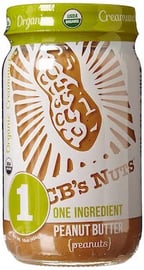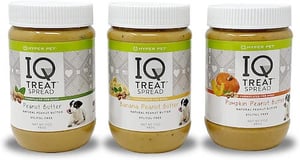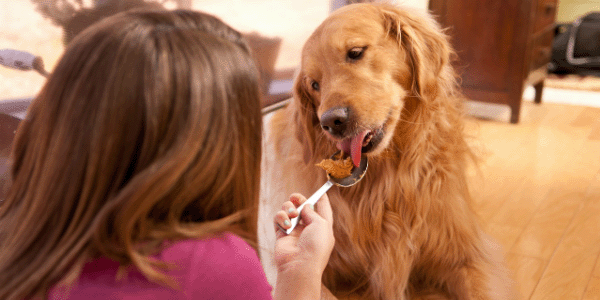 If you’re looking for a high-value treat, a handy way to sneak some pills into your pooch, or something to stuff into an interactive feeder, you can’t do much better than peanut butter.
If you’re looking for a high-value treat, a handy way to sneak some pills into your pooch, or something to stuff into an interactive feeder, you can’t do much better than peanut butter.
Not only is peanut butter a great snack to place in interactive feeders for dogs, but the sight of a dog vigorously smacking their chops never gets old.
Is It Safe to Give Peanut Butter to a Dog?
“Definitely… but!”
There are a few footnotes you should be aware of. As with anything, peanut butter is good in moderation, if your dog is healthy, and if you know which brands to avoid.
First, make sure your peanut butter is not one of the few that contains xylitol. This “all-natural” sugar-substitute is in a few brands of peanut butter, and though xylitol is safe for people, it’s deadly to dogs (even in small amounts). Check the jar’s label and look over our list of xylitol-containing peanut butters, which contains four brands as of the most recent count.
When you do find a dog-suitable peanut butter, it can be a wonderful source of protein and healthy fat for your dog. However, too much peanut butter can result in pancreatitis and obesity, so use sparingly if you're trying to help your dog lose weight.
Note that for dogs with food allergies, or on an “elimination trial” for suspected food allergies, peanut butter can possibly cause a food reaction or undermine the elimination trial.
Fortunately, the best way to limit the potential negatives of peanut butter is to just limit the amount of peanut butter you give your dog. (It’s also helpful to give your dog unsalted peanut butters that don’t contain added sugars, sugar substitutes, or other additives.) There are a number of natural peanut butters that should do the trick. Or, if you have a food processor handy and you’d like to tap into your inner Martha Stewart, you can mix up some homemade peanut butter.
Peanut Butter Recipe for Dogs
- Roast about 1/4–1/3 of a cup peanuts until they’re lightly brown
- With a food processor or sturdy blender, whip the peanuts until smooth
- Add a little oil to get the desired consistency
- You can even use animal-based oils, like fish oil
- Vegetable, peanut, or olive oils are great as well
There are also great single-ingredient peanut butter that you can find on Amazon or at your local grocery store – our favorites are listed below:
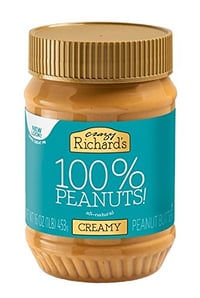 Crazy Richard's Organic Peanut Butter
Crazy Richard's Organic Peanut Butter
CB's Nuts Organic Peanut Butter
PREVENTIVE VET'S EXPERIENCE WITH THIS PRODUCT
I first tried the Banana Peanut Butter flavor when I was giving my seven-month-old Corgi a bath. I spread a bit on the side of the tub for him to lick while I washed him, and he didn't stop until bath time was over! I could scrub, rinse, trim his nails, and clean his ears without him batting an eye - he just wanted to lick up every last bit. After his bath, he kept trying to jump back into the tub to see if there was any more!
I love that there is no added sugar in this peanut butter, and that they have three flavors to pick from. After Fozzie Bear's fantastic bath experience, I went online and immediately ordered a three-pack so we could try the pumpkin and the regular flavor as well.
I use this as a special spread on my dogs' licking mats (I might have also spread some on my morning toast a few times ... it's human-grade and delicious). A little bit goes a long way – I spread about a tablespoon on each of their mats and popped them in the freezer. I gave each dog their mat for some "relaxation" time, and they both spent the next 40 minutes licking away happily. That's the longest any treat spread has kept their attention!
Overall Rating: 5 out of 5 stars ⭐⭐⭐⭐⭐
Note: Hyper Pet provided us with a free sample to test. We were not compensated or influenced in any way to produce this review. Read more about affiliate links here.
How Much Peanut Butter is OK for a Dog?
Disclaimer
This information should be taken as a general approximation, not a guide or recommendation for your specific dog’s daily calorie intake. There are many factors that impact a dog’s necessary calories, such as whether they’re neutered; their activity level; pregnancy; current body condition; diseases such as cancer, thyroid, and diabetes… just to name a few.Talk to your vet to determine how many calories per day your dog needs to maintain a healthy weight. And if you notice any change in your dog’s weight — either a gain or loss in weight — but haven’t changed their daily calories or exercise, it’s time to schedule a vet visit to determine the underlying cause.
As with any treat, peanut butter should be a complement to your dog’s regular meals, not a replacement. Do not give more than 10% of your dog’s daily calories in treats.
For quick reference, here is a breakdown of how much peanut butter you can give to a normally active, healthy dog (approximately, based on the calories in Skippy peanut butter, with about 95 calories per tablespoon).
| Dog Weight (in pounds) |
Approx. amount of peanut butter (in tbsp) per day |
| 20 | 3/5 |
| 30 | 1 |
| 50 | 1 1/6 |
Now before you jump to the cupboard for a jar of peanut butter, it's important to understand a few basic things about your dog’s diet and overall health. First, you’ll want to understand your dog’s optimal calorie intake, and to calculate that, you’ll need to figure out your dog’s ideal weight.
Dog-Calorie-Counter Cheat Sheet
Most dogs need between 20 and 40 calories per pound, per day.
- Smaller dogs typically need more calories per pound
- Larger dogs typically need fewer calories pound
A dog that weighs less than 20 pounds will need about 40 calories per pound per day.
- So a healthy, normally active 15-pound dog would need to eat about 600 calories per day (15 pounds x 40 calories per pound), depending on activity level.
A dog that weighs more than 50 pounds would need about 20 calories per pound per day.
- So a healthy, normally active 55-pound dog would need to eat about 1,100 calories per day (55 pounds x 20 calories per pound), depending on activity level.
For more information on calculating calories, check out this page from Ohio State University’s Veterinary Medical Center.
How to Balance Treat Calories With Meal Calories for Dogs
With peanut butter, or any treat, make sure not to give more than 10% of your dog's daily calories. Check out this dog treat calculator to figure out how many treats you can give your dog a day.
For example, if you have a 55-pound dog who eats 1,100 calories per day, then feed them NO MORE than 110 of those calories in peanut butter (or other treats), or roughly 1 1/6 tablespoons of peanut butter (based on the calories listed on a jar of Skippy peanut butter — check the label of your preferred peanut butter for the calories per tablespoon).
Or, if you have a 15-pound dog who eats about 600 calories per day, they should get no more than 60 of those calories in treats, or about 3/5 of a tablespoon of peanut butter.
How to Give Your Dog Peanut Butter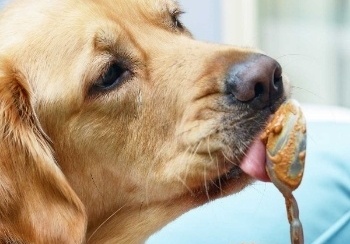
The secret to giving your dog peanut butter is… well, there isn’t a secret. Stuff peanut butter into a food puzzle, such as a Kong toy. Put a blob of peanut butter in your dog’s bowl. Or just scoop some onto your finger.
Peanut butter is particularly well suited to interactive feeders because A) your dog will really want to get out every last bit and B) it will take them a while to extract every last bit. A Kong toy stuffed with peanut butter should keep your dog occupied for quite a while, and they’ll love every minute.
Bonus Tip: If your dog is especially wily when it comes to food puzzles and interactive feeders, try freezing the toy with the peanut butter inside to create a frozen treat that will keep them entertained even longer. Or freeze it in their bowl for even more of a challenge.
How to Use Peanut Butter to Hide Dog Pills
Anyone who’s tried to medicate a dog will quickly realize that dogs are brilliant at spitting out pills. The trick is to hide the pill in something they’ll quickly gulp down without realizing it was a Trojan Horse for medication.
Depending on your dog and the size of the pill, straight peanut butter can be a fantastic way to hide pills. Simply place the pill on a spoon with a little bit of peanut butter, spread a little more over the top of the pill, and voila!
But if your dog is an expert pill-locator, you’ll need to be slightly more cunning. Take a small piece of bread, about the size of the end of your thumb, and spread peanut butter on one side. Then place the pill on the peanut butter and fold over either end to make a miniature sandwich. When you give this to your dog, they’ll most likely chomp the whole thing down in one bite without realizing what you snuck inside.
Is Almond Butter, Cashew Butter, or Nutella Safe for Dogs?
If peanuts aren’t really your thing — maybe you’re not partial to the humble legume — you’ve probably thought about giving your dog an alternative butter.
Almond butter is fine for dogs, as is cashew butter, though cashews are fattier than either peanuts or almonds and you’ll have to take this into account to prevent obesity and other health issues.
And even though dogs do not appear to have allergic/anaphylactic reactions to peanuts (which can be common and severe in humans), it is less known how individual dogs respond to other nuts and seeds. If you’re going to try an alternative, start out with tiny amounts and watch for these signs of an allergic reaction.
- Itchiness
- Chronic/recurrent ear infections
- Thin fur coat
- Impacted anal glands
- Less common signs might include vomiting, diarrhea, weight loss
One special note about Nutella, if that’s your butter of choice: Don’t give Nutella to your dog. There are better options. Full stop.
Nutella contains a small amount of cocoa powder; i.e., chocolate, which is toxic to dogs in large enough quantities. Although a little bit of Nutella contains a small amount of cocoa and probably isn’t enough to do any major damage, it really depends on the size of your dog — plus, it’s just not worth the risk. Your dog will enjoy another non-chocolate option just as much.
If you do have Nutella in your house, make sure it is safely out of reach of your dog — on a tall shelf, behind a secure cabinet door, or in your belly. And be especially careful if you have cats, as they have a knack for knocking items off counters that your dog will happily “clean up.”
Let us know if you have any additional questions about peanut butter or related topics.



